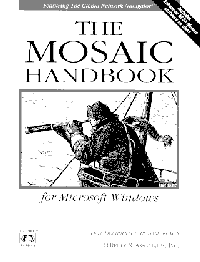The book scene is hotting up, and at last there are more worthy UK titles to add to the ranks of US titles

There appears to be a sea-change now under way, moving away from the “everything you wanted to know about the internet” type of book and toward more tightly focused titles such as those reviewed here. Whether this change is due to the market becoming more mature, or reaching saturation point I will leave to the readers’ sense of cynicism.
These two titles are amongst a small handful that zoom in on a specific part of the Internet; the World Wide Web (the sexy gee-whiz GUI bit, no Unix mantras to be found here) and a specific web browser, viz. NCSA Mosaic.
Of course WWW is not the Internet in the same way that Verdi is not Opera. It is rather analogous to the relationship between DOS and Windows. Windows is not (currently) an operating system in its own right but sits between the user and DOS. WWW is the same, merely a friendly layer between the user and the Mystic, Gothic and Romantic world of Unix and its disciples. Using a WWW browser exploration of the internet becomes easier.
Neither book could be described as for complete beginners. The Ziff book assumes, for instance, that you have skills in the Internet in general, and FTP in particular, so that you can download the software required to follow the remainder of the book (Trumpet, Mosaic and Win32s). The first chapter is a quick whiz through what the Internet is and the services that it can provide (USENET, FTP, WAIS, etc.). Chapter 2 gives an overview of hypertext and hypermedia, crucial for understanding the WWW. Chapter 3 covers the obtaining of the requisite software and installing it on your PC. The next 2 chapters cover the use of Mosaic itself to access resources and some of the programs features. The last chapter is the largest in the book and gives details of the most popular WWW information sources (at the time of publication).
There are 3 appendices catering for readers who just have to know how WWW works. They are: an HTML (Hyper Text Mark-up Language) command reference; a brief overview of HTTP (Hyper Text Transfer Protocol); and the MOSAIC.INI file settings.
The O’Reilly offering is one of a series of three, this being the Windows version. There are X-Windows and Macintosh versions also available. It has the advantage of coming complete with all the necessary software on diskette. The version supplied is an enhanced NCSA Mosaic from Spyglass .
The book covers the same ground as the Ziff book, though to my mind is more complete. It does not cover the installation of the software in as much detail, though this is not necessary because it installs straight off the supplied floppies. There are interesting items on multimedia and the Web including where to get hold of a couple of viewers, a more detailed romp through HTML including details of how to create your own Web page, and some thoughts on the future direction of the Web.
Both books obviously cover much of the same ground. It must be a tribute to the ease of use of Mosaic and the WWW that the actual ‘driving instructions’ contained in both books are remarkably small. The lions share of both is how to use Mosiac to get information rather than just how to use Mosaic.
The Ziff offering leaves you with the feeling that it only scratches the surface. Several times it leads you up blind alleys saying ‘you can even do this...’ and then does not bother to continue and tell you how. I have no quibble with the style: it is well written, but it is a slimmer book than its 156 pages suggest because of its copious use of Screen shots (66 in all and only 2 fit on a page), tables and lists. As a final aside the only glaringly obvious factual error in the book is the statement that Quarterdeck is “famous for its 386Max Memory Management software”. Ho, Ho, Ho!
The O’Reilly tome I think is the better of the two reviewed here. It has the advantage of coming complete with all the required software. It might not look so attractive on the shelf. It is rather conservative, set in a smaller typeface and does seem to have a higher word to picture ratio which might put off the bookstore browsers. It would appeal perhaps more to the technically minded reader.
Back to the issue 12 contents page...
Back to the infoHIGHWAY home page...